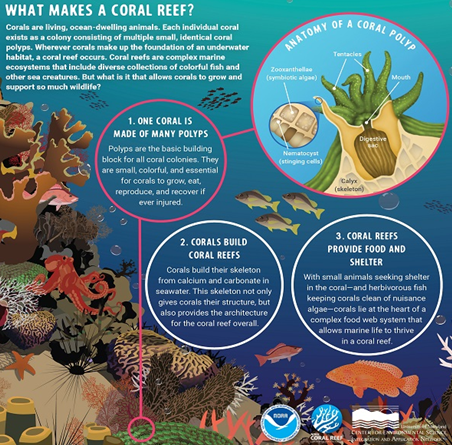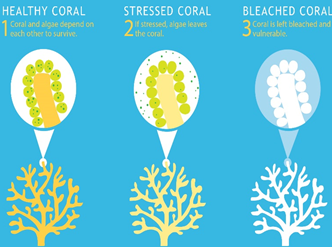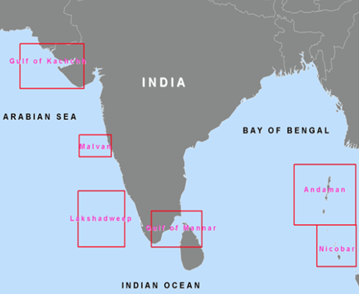The Coral Bleaching: Threat to marine ecosystem
-
Context
Recently the Australia’s Great Barrier Reef system has confirmed that the reef is experiencing a mass coral bleaching event.
- It happened for the fourth time in six years now denoting frequent bleaching events causing threat to marine ecosystem.

- It happened for the fourth time in six years now denoting frequent bleaching events causing threat to marine ecosystem.
-
Background
- The first time coral bleaching event was caused in 1998. The EL NINO effect weather had caused the sea surface temperature to rise in the Pacific Ocean.
- This event has caused 8%of the world’s corals to die.
- Corals can survive bleaching effects but stressed to more temperature changes and can subject to mortality.
- Second time it took place in 2002.
- Similarly in 2010, In Florida coral bleaching took place due to excessive cold water.
- One of the major events took place between 2014 and 2017, which has affected 14% of the world’s corals.
What are corals?
- Corals are marine invertebrates or animals not possessing a spine.
- Each coral is called a polyp and they live together in thousands to form a colony, which grows and multiply them to make copies of themselves.
- Corals are the largest living structures on planet.
Major types of corals:
- Hard corals- also called as hermatypic corals. They extract calcium carbonate from the sea water to build hard and white outer cover.
- Soft corals- they have appearance like plants, attach themselves to such skeletons and older ones build by their ancestors.

- The first time coral bleaching event was caused in 1998. The EL NINO effect weather had caused the sea surface temperature to rise in the Pacific Ocean.
-
What is coral bleaching?
Coral bleaching happens when corals experience stress in their environment due to changes in temperature, pollution or high levels of ocean acidity.
- Healthy corals- Coral and algae depend on each other to survive. Corals have a symbiotic relationship with microscopic algae called zooxanthellae that live in their tissues.
- These algae are the coral’s primary food source and give them their colour.
- Stressed Coral: if the corals are stressed then algae leaves the coral. When the symbiotic relationship becomes stressed due to increased ocean temperature or pollution, the algae leave the coral's tissue.
- Bleached coral: Coral is left bleached and vulnerable. Without the algae, the coral loses its major source of food, turns white or very pale, and is more susceptible to disease.

-
What causes bleaching?
- Climate Change: The leading cause of coral bleaching is climate change.
- Increased temperature: Changes in ocean temperature or increased ocean temperature are the leading causes of coral bleaching.
- Pollution: Runoff and pollution Storm generated precipitation can rapidly dilute ocean water and runoff can carry pollutants — these can bleach near-shore corals.
- Overexposure: Overexposure to sunlight can make temperatures high and high solar irradiance contributes to bleaching in shallow-water corals.
-
Impacts of coral bleaching
- On Biodiversity- coral reefs support over 25% of the marine biodiversity, including fish, turtles and lobsters. They make up 1% of the sea floor.
- The marine life supported by the reefs helps the fishing industry.
- Even giant whales also depend on reefs to live.
- On Economy- corals reef system generates 7 trillion dollar in annual economic value through goods and services trade and tourism.
- In Australia, coral reef system generates6 billion dollar worth trade annually.
- It provides employment to 60000 people including divers and guides.
- On environment- it helps to maintain flora and fauna in marine ecosystem
- It helps to prevent storm waves in oceans.
Present condition of the coral reef system
- According to the report of intergovernmental panel on climate change( IPCC)
- It has warned the life of Great Barrier Reef is in grave danger.
- Current bleaching effect has caused due to LA NINA effect.
LA NINA effect- when warm areas in the pacific ocean shifts, giving more cloud cover, rain and creating cooler weather conditions in the reefs in Australia.
- On Biodiversity- coral reefs support over 25% of the marine biodiversity, including fish, turtles and lobsters. They make up 1% of the sea floor.
-
What are the initiatives taken by India to conserve corals?
- Coral reef mapping and reef health monitoring –
- It is the initiative taken by India, where the coral reefs of Gulf of Kutchh, Gulf of Mannar, Andaman and Nicobar Islands, Lakshwadeep islands and Malvan are considered in Indian Ocean.
- Coral eco-morphological maps will be developed using satellite imageries in 1:25000 scales.
- This will indicate the health of corals and density etc.
- Global coral reef monitoring network-
- The first host institution for the new Implementation and Governance Plan is the Australian Institute of Marine Science, as part of Australia’s commitment to the ICRI Secretariat in 2019-2020 alongside co-chairs Monaco and Indonesia.
- The Global Coral Reef Monitoring Network (GCRMN) has been drawn up, utilising recommendations from a GCRMN meeting held in Townsville, Australia, on 23rd May 2017.
- Artificial coral formation-
- Materials used to construct artificial reefs have included rocks, cinder blocks, and even wood and old tires.
- Nowadays, several companies specialize in the design, manufacture, and deployment of long-lasting artificial reefs that are typically constructed of limestone, steel, and concrete.
- The first artificial coral reef has been commissioned in Kerela’s kovalam coast.
- It was 100m away from the coast and 30 m in breadth which was filled with sand to form’ soft reef ‘.

- Coral reef mapping and reef health monitoring –
-
Way forward
- Dead reefs can revive over time if there are enough fish species that can graze off the weeds that settle on dead corals, but it takes almost a decade for reefs to start setting up again.
- Artificial coral reefs are the future of the reef building in Indian Ocean to protect our marine ecosystem.
- Several governmental and intergovernmental Supports can bring a change in reducing the global Greenhouse gas emission and temperature to 5 degrees Celsius.
- Intergovernmental panel on climate change initiatives will make countries bound to scrutinize their coral reefs health.
-
Conclusion
Coral reefs are the largest living structure on earth has a great significance in marine ecosystem. There is an urgent need to reduce the carbon emissions and global temperature rises to make coral bleaching reduced.
India has a big role to play for its future commitments and targets to achieve to save environment and strategic Indian Ocean issues.

